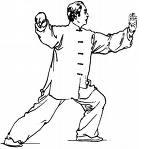Tai Chi Training – Phoenix Tai Chi London
 A set of warming up exercises designed to stimulate all the joints precede the Tai Chi workout. The exercises are essential and form the foundation of the Tai Chi pattern and training routine.
A set of warming up exercises designed to stimulate all the joints precede the Tai Chi workout. The exercises are essential and form the foundation of the Tai Chi pattern and training routine.
Along with the warm up preparation, a series of basic balance positions are learned. This helps the student to focus on posture and body carriage. During the execution of the form weight fluctuates from right to left placing the tai chi practitioner in full concentration to implement the form.
There are several stages involved in the learning process. The rate at which one learns Tai Chi varies with the amount of practice and individual dedication. A few short lessons from the teacher can help student to learn a few moves. However, to memorize the form is always a challenge; but with practice, discipline and continuity, one can reach an elevated physical and mental condition. Your self-awareness will improve and with each martial art technique within the movement learnt, your self-confidence will also grow.
 Other training exercises include weapons training employing the straight sword known as the jian or chien, folding fan also called san, wooden staff spear and lance.
Other training exercises include weapons training employing the straight sword known as the jian or chien, folding fan also called san, wooden staff spear and lance.
The ability to use tai chi as a form of self-defense in combat is the test of a student's understanding of the art. Tai chi chuan martially is the study of appropriate change in response to outside forces; the study of yielding and "sticking" to an incoming attack rather than attempting to meet it with opposing force. Push hands is a form of exercise designed to sharpen sensitivity in order to apply the art to an actual self-defence situation.
Tai chi's martial aspect relies on sensitivity to the opponent's movements and center of gravity dictating appropriate responses. Effectively affecting or "capturing" the opponent's center of gravity immediately upon contact is trained as the primary goal of the martial tai chi student. The sensitivity needed to capture the centre is acquired over thousands of hours of first yin (slow, repetitive, meditative, low impact) and then later adding yang ("realistic," active, fast, high impact) martial training; forms, pushing hands and sparring.

Tai chi trains in three basic ranges, close, medium and long, and then everything in between. Pushes and open hand strikes are more common than punches, and kicks are usually to the legs and lower torso, never higher than the hip depending on style. Strikes to the eyes, throat, heart, groin and other acupressure points are trained by advanced students. Joint traps, locks and breaks are also used.
Tai Chi can be practised by people of all ages, at any level of fitness. No special equipment is needed. No experience in martial arts is required though its internal approach can complement perfectly training of other arts.
 source: wikipedia
source: wikipedia

